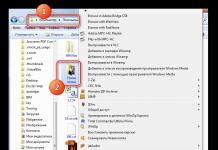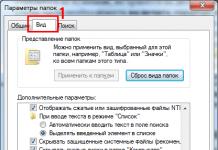There are two types of sharing:
- Local;
- Network.
In the first case, access is granted to directories located in your user directory "Users" ("Users"). In this case, other users who have a profile on this computer or who have started the PC with a guest account will be able to view the folder. In the second case, it is possible to enter the catalog over the network, that is, people from other computers can view your data.
Let's see how you can open access or, as they say in another way, share directories on a PC running Windows 7 using various methods.
Method 1: Granting local access
First, let's figure out how to provide local access to your directories to other users of this computer.


Now other users of this computer will be able to access the selected folder without any problems.
Method 2: Grant network access
Now let's figure out how to provide access to the directory from another PC over the network.
- Open the properties of the folder you want to share and go to the section "Access". How to do this was explained in detail in the description of the previous option. Click this time "Advanced Setup".
- The corresponding section window opens. Check the box next to "Share".
- After the checkbox is checked, the name of the selected catalog will be displayed in the fields "Share Name". You can also leave any notes in the field if you wish. "Note", but it is not necessary to do so. In the field for limiting the number of concurrent users, specify the number of users who can connect to this folder at the same time. This is done so that too many people connecting through the network do not create an unnecessary load on your computer. The default value in this field is "20", but you can increase or decrease it. After that click on the button "Permissions".
- The fact is that even with the above settings, only those users who have a profile on this computer will be able to enter the selected folder. Other users will not be able to visit the directory. In order to share a directory with absolutely everyone, you need to create a guest account. In the opened window "Group Permissions" click "Add".
- In the window that appears, in the field for entering the names of the selected objects, enter the word "Guest". Then press OK.
- There is a return to "Group Permissions". As you can see, the entry "Guest" appeared in the list of users. Select it. At the bottom of the window is a list of permissions. By default, users from other PCs are only allowed to read, but if you want them to be able to also add new files to the directory and modify existing ones, then opposite the indicator "Full access" in a column "Allow" check the box. At the same time, a mark will also appear next to all other items in this column. Perform a similar operation for other accounts displayed in the field "Groups or Users". Next click "Apply" And OK.
- After returning to the window "Advanced Sharing Settings" press "Apply" And OK.
- Returning to the folder properties, move to the tab "Safety".
- As you can see, in the field "Groups and Users" there is no guest account, and this can make it difficult to enter the shared directory. Click on the button "Change…".
- A window opens "Group Permissions". Click "Add".
- In the window that appears, in the field for the names of objects to select, write "Guest". Click OK.
- Returning to the previous section, click "Apply" And OK.
- Next, close the folder properties by clicking "Close".
- But these manipulations do not yet provide access to the selected folder over the network from another computer. You need to take a few more steps. click button "Start". Come in "Control Panel".
- Choose a section "Network and Internet".
- Now sign in "Network Control Center".
- In the left menu of the window that appears, click "Change advanced options...".
- A window for changing parameters opens. Click on the name of the group "General".
- The content of the group is open. Go down the window and put the radio button in the position of disabling access with password protection. Click "Save Changes".
- Next, go to the section "Control Panels", which bears the name "System and safety".
- click "Administration".
- Choose from the available tools "Local Security Policy".
- On the left side of the window that opens, click "Local Policies".
- Go to catalog "User Rights Assignment".
- In the right main part, find the parameter "Deny access to this computer from the network" and go into it.
- If there is no item in the window that opens "Guest" then you can just close it. If there is such an item, then select it and press "Delete".
- After deleting the item, press "Apply" And OK.
- Now, if there is a network connection, sharing from other computers to the selected folder will be enabled.



























As you can see, the algorithm for sharing a folder depends primarily on whether you want to share the directory for users of this computer or for users to log in over the network. In the first case, it is quite simple to perform the operation we need through the properties of the directory. But in the second, you will have to thoroughly tinker with various system settings, including folder properties, network settings and local security policy.
The fastest way to share certain items is to use the new menu Allow sharing for.
The options displayed depend on the files being shared and the type of network your computer is connected to—homegroup, workgroup, or domain.
Sharing files and folders in a homegroup
- Right-click the item you want to share and select Allow sharing for.
- Select one of the following options.
- Home group (reading) This option grants access to the item to the entire homegroup, but only to open it. Homegroup members can't edit or delete an item.
- Homegroup (read/write) This option grants the entire homegroup access to the item to open, edit, and delete it.
- Certain users This option opens the File Sharing Wizard, allowing you to select individual users to share items with.
With the File Sharing Wizard, you can select specific users to share files and folders with.
Notes:
- If you don't see the "Allow Sharing For" menu, you may be trying to share a file that's on a network or somewhere else that isn't supported. It also does not appear if a file in a personal folder is selected.
- If you're trying to grant access to certain users in your homegroup, but their names don't appear in the File Sharing Wizard, they may not have associated their Windows accounts with an online ID. You may also need to install an online ID provider on your computer.
Sharing files in a workgroup or domain
- Right-click the item you want to allow access to, select Allow sharing for and choose Certain users.
- In the File Sharing Wizard, click the arrow next to the text box, select a name from the list, and then click the Add button.
Advice: If you already know the name of the person you want to share the files with, enter the name in the File Sharing Wizard and click the Add button.
- In column Permission level select one of the following options.
- Reading. Recipients can open the file, but they can't modify or delete it.
- Read/Write. Recipients can open, modify, or delete the file.
- After adding users, click the button Allow access.
- Once you've received confirmation that you've shared an item, you'll need to notify the users you've shared with them about how to access it. Perform one of the following actions:
- If you have an email program installed, click email to send a link to shared files.
- Click Copy to automatically copy the reflected links to the Windows Clipboard. You can then paste it into an email message, instant messages, or another program.
- When finished, click the Finish button.
Notes:
- If you don't see the "Allow Sharing For" menu, you may be trying to share a file that's on a network or somewhere else that isn't supported. It also does not appear if a file in a personal folder is selected.
- When password-protected sharing is enabled, the user who is granted access must use an account and password to log into the computer and access shared items. Password protected sharing settings can be found in the control panel under . This feature is enabled by default.
- When you try to share items in shared folders in Windows 7, the Allow Sharing For menu displays an option called Advanced Sharing Options. This option opens the Control Panel, where you can enable or disable access to shared folders.
Stop sharing a file or folder
- Right-click on the file you want to stop accessing, select Allow sharing for and select No .
Access on other computers in the homegroup
- Click the Start button and select your username.
- In the Navigation Pane (left side), under HomeGroup, select the account whose files you want to access.
- In the file list, double-click the library you want to access, and then double-click the item.
Note: The Navigation Pane does not display computers that are offline, or computers that are in sleep or hibernation mode.
Shared Folders
You can also share files and folders by copying or moving them to one of the shared folders in Windows 7, such as Shared Music or Shared Pictures. To find them, click the Start button, click your username, and then click the arrow next to Libraries to expand the folder.
Shared folder sharing is enabled by default (except for HomeGroup).
Turn public folder sharing on or off
When public folder sharing is enabled, anyone on the computer or on the network can access those folders. When disabled, only users with a user account and password on the computer have access.
- Extend the current network profile.
- In field General access in the Public folder, select one of the following options.
- Enable Sharing so that all users with network access can read and write files in shared folders.
- Disable shared folder access(Users who are already signed in to the computer can still access these folders)
- Click the button Save Changes.
Notes:
- When using a shared computer folder with other users, they can open and view the files that are hosted there, that they are stored on their own computers. If you give them permission to modify files, any changes you make will show up in the files on your computer.
- When you click a shared folder or its contents, the Share with menu will display More Sharing Options. This option opens the Control Panel, where you can enable or disable access to shared folders.
By enabling password-protected access in Control Panel, you can restrict access to a shared folder to only users who have a user account and password on the computer.
Turn password protected sharing on or off
- Open the Advanced Sharing Options window.
- Click to expand the current network profile.
- In chapter Password protected sharing select one of the following options:
- Enable password protected sharing
- Disable password protected access
- Click the button Save Changes.
Shared folders are contained in Windows Libraries.
More sharing options
In some places in Windows, for security reasons, you cannot directly share items using the Share with menu. For example, you can share the entire C drive on your computer (called the root drive) or system folders (specifically Users and Windows folders).
To share these locations, you must use advanced sharing options instead. However, in general, we do not recommend giving access to the entire drive or Windows system folders.
More sharing options
- Right click the drive or folder, select Allow sharing for and choose Additional access options.
- In the dialog that appears, click .
- In the dialog box More sharing options check the box Share this folder.
- To specify users or change permissions, click Permissions.
- Click the Add or Remove button to add or remove users or groups.
- Select each user or group, select the checkboxes for the permissions that you want to grant to a specific user or group.
- When finished, click the OK button.
Note: You cannot grant access to the root of a drive with a dollar sign after the letter, which was possible in versions of Windows prior to Windows Vista. For example, the root of drive C cannot be made available as "C$", but it can be made available as "C" or any other name.
While computers with an old but beloved one, XP perfectly detect each other on the network and see folders that are open for public access.
In windows 7, work with networks and sharing has been radically redesigned. “Network placements” appeared (home, work, public network and domain network) and this was done, of course, for our benefit, but it turned out, as they say, as always.
By default, the seven defines all new networks as public, and very strict security rules are set for them: network discovery is disabled (the computer is blind and cannot be seen by other machines), file and printer sharing is disabled (other computers do not see shared folders, folders, printers ), access to the computer from the network is password-protected.
From the dark days of Windows Vista, many people remember that network location selection screen that appears every time a computer connects to a new network.
.png)
So, how to open file access over the network in windows 7 ( share files)?
You can select Home Network each time you select a network location. And you can once set up a computer for convenient use when connected to any network with the inhabitants of which you want to share files. If you are concerned about the safety of your confidential data, simply do not provide access to them and try not to open files and folders with full access (for writing and reading).
If you are afraid that third parties will have access to your files when, for example, you are at the airport and connected to a Wi-FI network, install the program
Kill Watcher
and close access to your computer from the outside with two mouse clicks. Kill Watcher stops the server service and your files become unreadable over the network.
.png)
Preparing for sharing
Click on the network icon in tray and follow the link to Network and Sharing Center.
.png)
.png)
In the window that appears, set the values of the switches, as shown in screenshot:
.png)
Note. I do not recommend opening access so that network users can read and write files in shared folders. These folders are located on the "C" drive, and separating write access to them, you open the way for trojans and viruses to your machine. Do this only if you know all the computers on the network and have anti-virus software installed.
How to share a file or folder
Right click on the folder or file and go to Properties.
.png)
Go to the tab Access and click on the button Advanced setup
.png)
Place a check next to Share this folder and click on the button Permissions
.png)
Click Add
.png)
In the window that appears, click the button Additionally
.png)
Click the button Search in the middle right (1) - a list of services and users will appear in the lower field of the window (2). Scroll down the list and find Net. Highlight Net(3) left click and click OK(4). Then one more time OK.
.png)
In the field highlighted in yellow, you can set the rights for users who will connect to you over the network.
.png)
The differences between full access, modification and reading are shown in this table (material from Windows Help).
.png)
In short, the only difference between full access and modification is that with full access it will be possible to delete files.
When you have set the desired permissions for users, click OK two times and go to the window properties folders per tab Safety. Next, you need to perform actions similar to those that we performed when setting permissions.
Click the button Change.
.png)
In the window that appears, click Add.
.png)
Click the button Additionally in the next window.
Some system folders in Windows are hidden from the user so that they do not accidentally delete or change important files that the OS depends on. In addition, folder sharing is generally restricted. To remove these restrictions, you must specify the appropriate settings.
To make hidden folders visible, open the Start panel and click on Computer. At the top left, find the "Organize" option, expand the drop-down list and select "Folder and Search Options". In the window that appears, open the "View" menu, scroll down the list and under the "Hidden files and folders" option, select the "Show hidden folders, files and drives" item. Click OK. You have access to all hidden directories. Sharing a folder will allow different user accounts to get permissions to share files and other permitted actions within it. Access can be done both locally and through the network. By default, Windows 7 has one shared folder − Public. It can store videos, music, photos and other files for sharing or review.





It is not recommended to share the root directory of the system drive, as well as the Windows and Users folders. Even if you bypass the restrictions imposed by the system, it may adversely affect the operation of the computer. Use a folder to share data Public, copying files there to the appropriate directories: music to the Shared Music folder, photos to Shared Images, etc. This method will always come in handy if you have difficulty accessing a regular folder that is not related to Public.
This article will show you a simple way to configure file access on Windows 7, for those cases when you need to provide anonymous access to Windows 7 shares. This setup assumes that network access will be without a password, without restrictions. This is a common situation for home and office networks.
Similar articles for other OS:
So, step by step.
Allow sharing for a folder
In Explorer, you need to find the folder that you want to share (share it) and right-click on it. In the context menu, open the Properties of this folder. In the properties window, go to the "Access" tab and click the "Sharing" button:
After that, in a new window, you need to specify full permissions for the "Everyone" user group:


After clicking the "Finish" button, this folder will become available over the network:

Now in the properties of the folder you can see that it is available over the network:

Configuring Windows 7 network settings
Next you need to open Network and Sharing Center" (through the Network icon in the tray or through the Control Panel) and in the left part of the window click on "Change advanced sharing settings":

In the next window, your local network profile will immediately open - there you need to enable two parameters and click the "Save changes" button:

After that, in the same window, go to the "General" profile:

And there disable the option "sharing with password protection" and of course click the "Save changes" button:

This completes setting up network access without a password for Windows 7. Now it will be possible to access this computer via the local network and Windows will not require you to enter a password.
If Windows requires a network password
Despite the fact that the settings described above are made, when you log on to this computer, another computer may request a network password. This is possible if both computers have local users with the same username but different passwords.
There are two solutions to this problem:
- Remove matching usernames.
- Specify the same password for users with the same login. An empty password is also considered the same.
How to Unshare a Folder in Windows 7
On Windows 7, the cancellation of sharing is not at all obvious, unlike in Windows XP. On Windows 7, to cancel sharing, you need to click the "Advanced Settings" button on the "Access" tab and turn it off there. Microsoft developers have a peculiar logic.


Share Windows 7 Folder via Command Prompt
File sharing can be set up much faster if you use the command line (console, cmd.exe). Just one command to execute in the console:
net share files=c:\files
It shares the folder c:\files and sets a network name for it files.
Through the console, you can also cancel sharing:
net share files /delete
This command deletes a network (shared) folder files. Folder c:\files of course stays in place.
Sharing Windows 7 files through the Shared Folders snap-in
The Windows 7 Management Toolkit includes a special program (snap) for managing the shares on your computer. It is called "Shared Folders" and you can run it with the command fsmgmt.msc(in console or via Win+R):

Otherwise, this snap-in can be opened through the Start menu: "Control Panel - Administrative Tools - Computer Management - Shared Folders".
Configuring passwordless access for other operating systems
If you live in Krasnodar and you need to set up a local network in Windows
If you found this article useful or just liked it, then don't be shy - support the author financially. This is easy to do by throwing money on Yandex Wallet № 410011416229354. Or on the phone +7 918-16-26-331 .
Even a small amount can help writing new articles :)



































